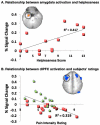Association of major depressive disorder with altered functional brain response during anticipation and processing of heat pain
- PMID: 18981339
- PMCID: PMC2702160
- DOI: 10.1001/archpsyc.65.11.1275
Association of major depressive disorder with altered functional brain response during anticipation and processing of heat pain
Erratum in
- Arch Gen Psychiatry. 2009 Jan;66(1):63
Abstract
Context: Chronic pain and depression are highly comorbid conditions, yet little is known about the neurobiological basis of pain processing in major depressive disorder (MDD).
Objective: To examine the neural substrates underlying anticipation and processing of heat pain in a group of unmedicated young adults with current MDD.
Design: Functional magnetic resonance neuroimaging data were collected during an event-related factorial experimental pain paradigm. Painful and nonpainful heat stimuli were applied to the left volar forearm while different color shapes explicitly signaled the intensity of the upcoming stimulus.
Setting: University brain imaging center. Patients Fifteen (12 female) young adults with current MDD and 15 (10 female) healthy subjects with no history of MDD were recruited and matched for age and level of education. The Structured Clinical Interview for DSM-IV was administered to all participants by a board-certified psychiatrist. Main Outcome Measure Between-group differences in blood oxygen level-dependent functional magnetic resonance neuroimaging signal change to anticipation and processing of painful vs nonpainful temperature stimuli.
Results: Subjects with MDD compared with healthy controls showed (1) increased activation in the right anterior insular region, dorsal anterior cingulate, and right amygdala during anticipation of painful relative to nonpainful stimuli, (2) increased activation in the right amygdala and decreased activation in periaqueductal gray matter and the rostral anterior cingulate and prefrontal cortices during painful stimulation relative to nonpainful stimulation, and (3) greater activation in the right amygdala during anticipation of pain, which was associated with greater levels of perceived helplessness.
Conclusions: These findings suggest that increased emotional reactivity during the anticipation of heat pain may lead to an impaired ability to modulate pain experience in MDD. Future studies should examine the degree to which altered functional brain response during anticipatory processing affects the ability to modulate negative affective states in MDD, which is a core characteristic of this disorder.
Figures




Similar articles
-
Decreased frontal regulation during pain anticipation in unmedicated subjects with major depressive disorder.Transl Psychiatry. 2013 Mar 12;3(3):e239. doi: 10.1038/tp.2013.15. Transl Psychiatry. 2013. PMID: 23481626 Free PMC article.
-
Emotion processing, major depression, and functional genetic variation of neuropeptide Y.Arch Gen Psychiatry. 2011 Feb;68(2):158-66. doi: 10.1001/archgenpsychiatry.2010.197. Arch Gen Psychiatry. 2011. PMID: 21300944 Free PMC article.
-
Increased affective bias revealed using experimental graded heat stimuli in young depressed adults: evidence of "emotional allodynia".Psychosom Med. 2008 Apr;70(3):338-44. doi: 10.1097/PSY.0b013e3181656a48. Epub 2008 Mar 31. Psychosom Med. 2008. PMID: 18378870 Free PMC article.
-
Functional imaging of brain responses to pain. A review and meta-analysis (2000).Neurophysiol Clin. 2000 Oct;30(5):263-88. doi: 10.1016/s0987-7053(00)00227-6. Neurophysiol Clin. 2000. PMID: 11126640 Review.
-
Imaging phenotypes of major depressive disorder: genetic correlates.Neuroscience. 2009 Nov 24;164(1):300-30. doi: 10.1016/j.neuroscience.2009.03.082. Epub 2009 Apr 7. Neuroscience. 2009. PMID: 19358877 Free PMC article. Review.
Cited by
-
Impaired interhemispheric connectivity in medication-naive patients with major depressive disorder.J Psychiatry Neurosci. 2013 Jan;38(1):43-8. doi: 10.1503/jpn.110132. J Psychiatry Neurosci. 2013. PMID: 22498077 Free PMC article.
-
Power of narrative: a case study about documenting private insightful experiences while dealing with pain and associated disability.Front Digit Health. 2023 Dec 22;5:1289373. doi: 10.3389/fdgth.2023.1289373. eCollection 2023. Front Digit Health. 2023. PMID: 38187187 Free PMC article.
-
Pain imaging in health and disease--how far have we come?J Clin Invest. 2010 Nov;120(11):3788-97. doi: 10.1172/JCI43498. Epub 2010 Nov 1. J Clin Invest. 2010. PMID: 21041961 Free PMC article. Review.
-
Pain and Psychology-A Reciprocal Relationship.Ochsner J. 2017 Summer;17(2):173-180. Ochsner J. 2017. PMID: 28638291 Free PMC article. Review.
-
Neural systems approaches to understanding major depressive disorder: an intrinsic functional organization perspective.Neurobiol Dis. 2013 Apr;52:4-11. doi: 10.1016/j.nbd.2012.01.015. Epub 2012 Feb 10. Neurobiol Dis. 2013. PMID: 23477309 Free PMC article. Review.
References
-
- Lepine JP, Briley M. The epidemiology of pain in depression. HumPsychopharmacol. 2004;19(Suppl 1):S3–S7. - PubMed
-
- Bair MJ, Robinson RL, Katon W, Kroenke K. Depression and pain comorbidity: a literature review. ArchInternMed. 2003;163(20):2433–2445. - PubMed
-
- Gameroff MJ, Olfson M. Major depressive disorder, somatic pain, and health care costs in an urban primary care practice. The Journal of clinical psychiatry. 2006;67(8):1232–1239. - PubMed
-
- Phillips ML, Drevets WC, Rauch SL, Lane R. Neurobiology of emotion perception I: The neural basis of normal emotion perception. Biological psychiatry. 2003;54(5):504–514. - PubMed
-
- Kirsch I. Response expectancy as a determinant of experience and behavior. American Psychologist. 1985;40(11):1189–1202.
Publication types
MeSH terms
Substances
Grants and funding
LinkOut - more resources
Full Text Sources
Other Literature Sources
Medical

